“Time Waits For No Digger”
Do you envision the perfect spring garden? No matter how blustery the day and how wintery your garden is, as the days grow longer you feel that strengthening urge to dig in the earth! If you are reading the plant and seed catalogs while looking out into the snow, this list is for you. You are already planning your early spring garden -it’s not too soon to take steps to get it ready.
Most of these steps can be done about one month before planting time. Some even earlier. Preparing tools and equipment can start sooner, especially if you have big plans. Before planting, we all have the luxury of time to do the right preparations; after we start planting, things can get pretty busy! This should help you have spring garden success.
Seven Proven Steps to a Perfect Spring Garden
- Inspect the Scene Of the Crime
- Spring Cleaning
- Polish and Repair Your Tools
- Prepare the Soil
- Prune Woody Plants
- Divide Perennials
- Plant Beds, Borders & Perennials
What Our Spring Gardens Have Taught Us
Landscape and garden design is all about planning for change. This includes the inevitable changes in living plants as well as the effect of seasonal change. The developing seasons are part of what makes gardening interesting. It is never the same garden you step into each day with your hoe in hand. The effect of new seasonal colors alone requires careful attention to keep the garden captivating. Approach it as a challenge; the idea is that it is fun! The old line is right. “Plan your work, then work your plan”.
Consider Your Planting Zone
We spent most of our lives as northern gardeners in a wide variety of climates, and, the latest adventure, getting used to “upside-down” Florida has been a challenge.
If you are like us and garden in Florida’s near-tropical climate, you have been digging all winter and enjoying the results. Also, your early spring garden has long since passed by. You have been surrounded by plants that your northern neighbors will use this summer. As time passes even your time to enjoy some of them is running out. When the hot, wet summer comes, you will need some different plant materials.
(Thinking of Florida? Here is what February is like.)
Here is an example. February has had some warm days. All winter, our containers have thick trails of large petunia blossoms hanging down. The undersides of the stems are beginning to brown. We trim them off, and they should perform another flush of blooms. In temperate climates, gardeners will do the same thing but much later, in mid to late summer.

The Seven Steps to Your Perfect Spring Garden
1. Inspect The Scene Of The Crime

We love those old classic murder mysteries! Agatha Christie was right. It is all about a great plot! If you can take a systematic approach you will make spring gardening easy on yourself. As her great detective, Hercule Poirot says “Use the little gray cells.”
Check These Things Off
- First, take stock of the situation- is there old plant material to be removed, the remains of old annuals, and plant remains left to feed the birds?
- Do you have winter-killed branches to remove?
- Overcrowded beds with plants needing division?
- Bare spots needing new plant material or a focal point in the form of a specimen planting or even statuary or decor
- Problems you never solved, places where nothing grows, you know, “a zone of death,” erosion, rocky places?
- When the danger of cold is gone, it is time to remove the protective burlap from the shrubs.
If hardscape, pavers, walkways etc, are damaged, repairing them is the first order of business.
2. Spring Cleaning! (no, you can’t avoid it)
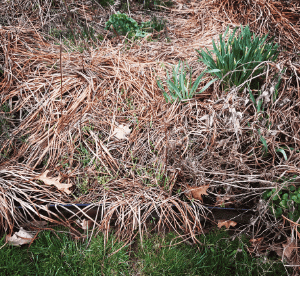
When winter is over, here is what to do.
- Clean up any plant debris; dead materials can include fungus and disease that may present a later problem.
- Remove winter mulch, and you can incorporate leaves into the soil where they will decompose for your benefit.
- For perennials, remove any dead materials; for annuals, remove the unwanted plants.
- Prune shrubs and trees to encourage new growth. (Here is a spring pruning chart.)
- Wait for flowering shrubs and trees to finish blooming before pruning.
- Detach any vine material before new growth shows up
- Edge the garden beds
- Look in the crowns of perennial plants for any overwintering slugs, snails, and aphids.
- Remove any living weeds; leaving them will allow the seeds to grow and compete with your plants. Have a disposal plan. We have a weekly county-sponsored pickup.
The Age-Old Question You Ask Every Spring!
Is It Dead?
IF It looks bad, ask yourself these questions. Can it be salvaged? Then ask is it worth the effort?
Follow the clues, you can’t call the detective, you need to figure it out.
- Falling leaves look bad, but check the stems; a living stem is pliable but firm. Scratch the surface. Is it green inside? If the stem is dead, are the roots also dead? Time to check them; if they are firm and pliable, the roots are alive.
- Signs of pest damage, look for chewed holes, and residue, that’s a pest problem. Disease, however, is usually evidenced by discolored and spotty leaves.
- It’s a plant; it’s not really a murder victim. Is it worth saving? In our family of gardeners, we still have some plants grown by our grandmother. I have cuttings of my mother’s aloe vera plant. We will try hard to keep these alive. Conversely, if a plant is inexpensive or easy to replace, or worse, you see a disease that can spread, write it off. You decide.
3. Clean and Repair Your Tools
Then Add The New Ones Which Will Make Your Work Easier
- Start with the greenhouse or garden shed, and clean, and arrange any tools and equipment. You will have long days this spring and you will appreciate being able to find everything.
- Clean the tools and make any needed repairs
- Eliminate rusty tools and any that pose any danger to you
- Clean the metal parts with a wire brush
- Sharpen all the blades. If there are tools that cannot be sharpened and are dull-replace them. The safest tool is sharp and respected for that reason.
- Wash containers you will reuse with a brush and a weak solution of bleach, and recycle any plastic pots you will not use.
What Constitutes A Useful Selection Of Tools
It’s been about 10,000 years since humans began coveting garden tools and we have never stopped. That part has not changed. Just search “best garden tools.” Your problem will not be too few offerings! All of us gardeners have got an opinion, and we are very willing to share them. It started with the “Microlith.” That was a stone blade attached to a wood handle. Don’t worry, you can do a lot better than that!
The Early Wheelbarrow
I wouldn’t love to push it but it does have charm. The wheelbarrow dates back to China, in the second century B.C. While we love the big rubber tires and new lighter-weight tools, the wheelbarrow has not changed all that much!
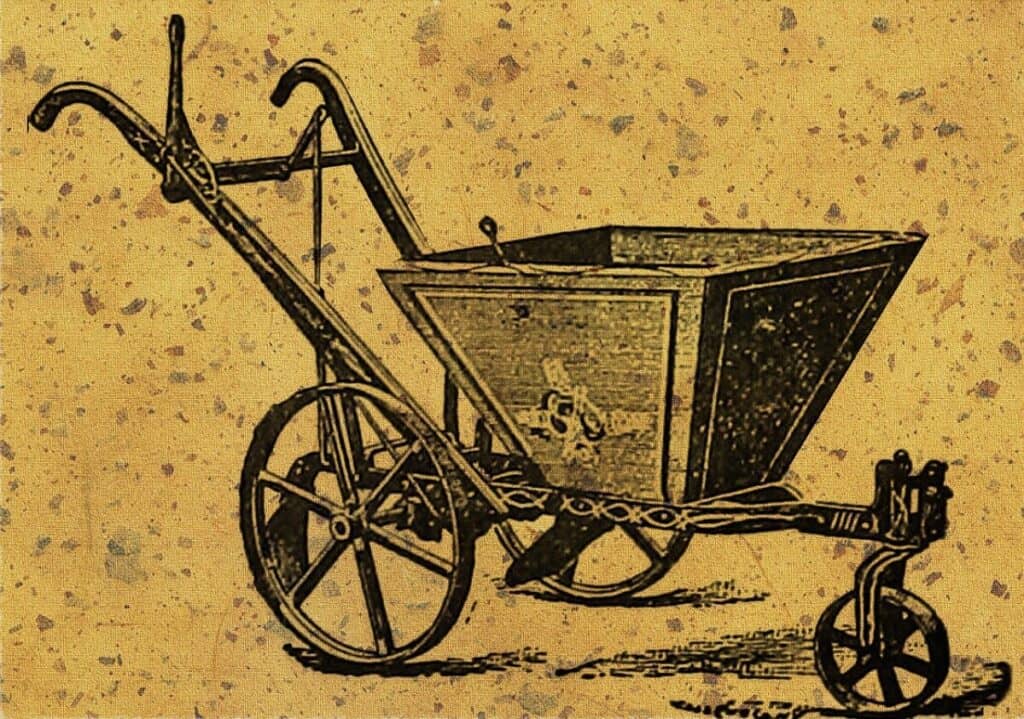
Tool Choices
There are lots of offerings out there. Tools today are a combination of tried and true aides, as well as new materials and innovative ideas. The important thing is to tune out the noise and the hype and own only those items that will make you productive and comfortable in the garden.
Some tools are basic, we all need them. You need a shovel to dig in the dirt. Exactly what kind can be affected by where and how you garden?
The following is a list of what works for us. Some tools are new to us, and we love them. In other cases, (we brag a little) we are the second generation of family gardeners to use them. (Can they last another?)
Some Tools We Have Learned To Love
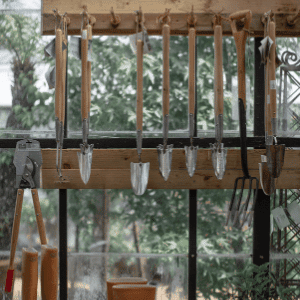
This is what you will depend on day and day out.
Here is a list of tools we have come to rely on in our garden. From that list are two tools that surprised us by being better than we expected. Today we would not go into the garden without any of them. If one of these tools were broken we would replace it immediately.
The list starts with long tools, then cutting tools followed by hand tools and accessories we think are necessities.
Long Tools
- Two cultivators, a long one and a shorter length.
- Three rakes. One standard leaf rake for leaves, lawn, and general clean-up. A narrow leaf rake is also called a shrub rake. These are wonderful for cleaning up small spaces between plants. We prefer metal to plastic as the plastic tines seem more likely to break—lastly, one horizontal, metal soil and garden rake.
- A garden hoe. The plain kind, with the sharp metal base perpendicular to the handle. This will help you dig up weeds, and break up small roots, move stones and buried debris.
- A sturdy, sharp shovel with a point. This preference may be regional, although we have always used this tool. In Florida, what we call “soil” requires some imagination. It is sandy, with rocks and lumps of all sorts. The pointy shovel cuts into it as easily as possible. A wide shovel would be hard to use.
- An edger to cut clean borders around garden beds and walkways. We like a traditional half-moon style with a step for your foot. It cuts sod cleanly.
Cutting Tools
- Hand pruning shears. We prefer the kind which can be sharpened or have the blades replaced. Sharp is safe for us and healthier for the plants. (They need to be cut, not crushed.)
- Lopping shears, these are pruning shears with handles 24″-30″ long. These are for cutting branches of trees and shrubs up to about 2″ in diameter. The blades need to be sharpened or replaced as needed.
- Other cutting tools. I carry a pair of scissors, and my husband goes nowhere without a garden knife. There are always plants to tie up, herbs to cut for dinner, flowers to deadhead, bags to open… the list goes on. A garden knife: this is an innovative Japanese garden tool. It is called a “Hori-Hori” knife. It means “Diggy-Diggy. You carry it around on a convenient holster. It makes you sheriff of the garden. With a serrated side and a smooth side, a sturdy handle, and marked off by inches to measure depth, it is handy and versatile. With it, you can plant smaller plants, dig in bulbs, cut roots and vines, and dig out weeds. Your imagination is pretty much its only limitation.
Hand Tools and Accessories
- Until recently, I would have added two trowels (narrow and wide) and a bulb planter. You may choose to add them; for us, with the Hori Hori knife, they have not recently left the closet. Soon I will plant a bunch of caladiums, this is my favorite tool for the bulb planting task.
- Two tree saws, a hand saw, and a pole saw for the high places.
- Basic power tools: a hedge trimmer and a string trimmer for edging. A blower to keep things clean. It cleans the porch, patio, walkways, anywhere there is a mess. Where we live, we do not need a lawnmower. That is a community service. Our service would also prune for us but at an institutional level. We like to keep the fun jobs for ourselves.
- A good garden kneeler. Gardeners don’t cover a lot of ground, but we travel up and down a lot. A comfortable kneeler will save the knees a lot of discomfort. We love the kind that turns into a folding seat. It provides different, comfortable positions for close work.
- Gloves, three kinds. Everyday snug gloves for a good tactile experience. (They might extend the manicure a little.) I like the kind with a waterproof coating on the palm and fingers with a knitted back for some air. Never run out of gloves, they should be inexpensive; I buy a package of them at a time. Heavy leather gloves that cover the wrists for dirty work. We trim a lot of palms; Heavy gloves are a big help—Rose Gauntlet Gloves with elbow-length gauntlets. We can grow roses where we live, but the bougainvillea, agave, and some of the palms are also a good reason to use them.
- A hat! Sun damage can have terrible consequences. Just wear a good hat, sunglasses, and sunblock.
More On Tools
“The Best Garden Seat and Kneeler“
“Sun Protection In The Garden“
“Trying Out A Hori Hori Knife”
Do You Have A Tool Shed Or A Greenhouse?
Clean the place where you store your tools. If supplies need to be reordered, replace what you need before planting time.
Clean and wash the greenhouse, washing the outside will remove any algae, grass, dirt, and grime. You will see out the windows and the plants will start better. Wash the inside and workspace with garden disinfectant. Wash planters and planter trays. Recycle any plastic planters you will not use. The big box stores have recycling services, wash out the unwanted plant pots and bring them by. It is a good service and we appreciate it.
Will You Use Trellises, Arbors, Poles, Cages? Do You Have Garden Seating or Decor?
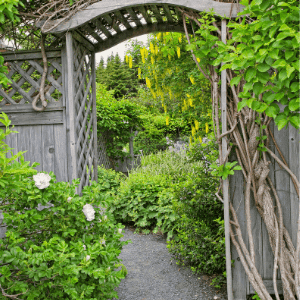
Check all of these early in ln the season for needed repairs. When things start growing you will need the features and you will get tired, and relish a rest on your clean garden bench.
Do You Have, Or Have Room For A Rainbarrel Or A Composter?
Install a rain barrel if you have space. Some plants are acid-loving and as tap water is slightly alkaline they will perform better with rainwater.
- Camillia, rhododendron and blueberries.
Create a composting space if you have room. There are self-enclosed composters for small spaces.
If you have compost, check it in late winter for sogginess due to weather. Adding grass or other fine materials will separate the material and allow for the oxygen your plants need.
4. Preparing The Soil
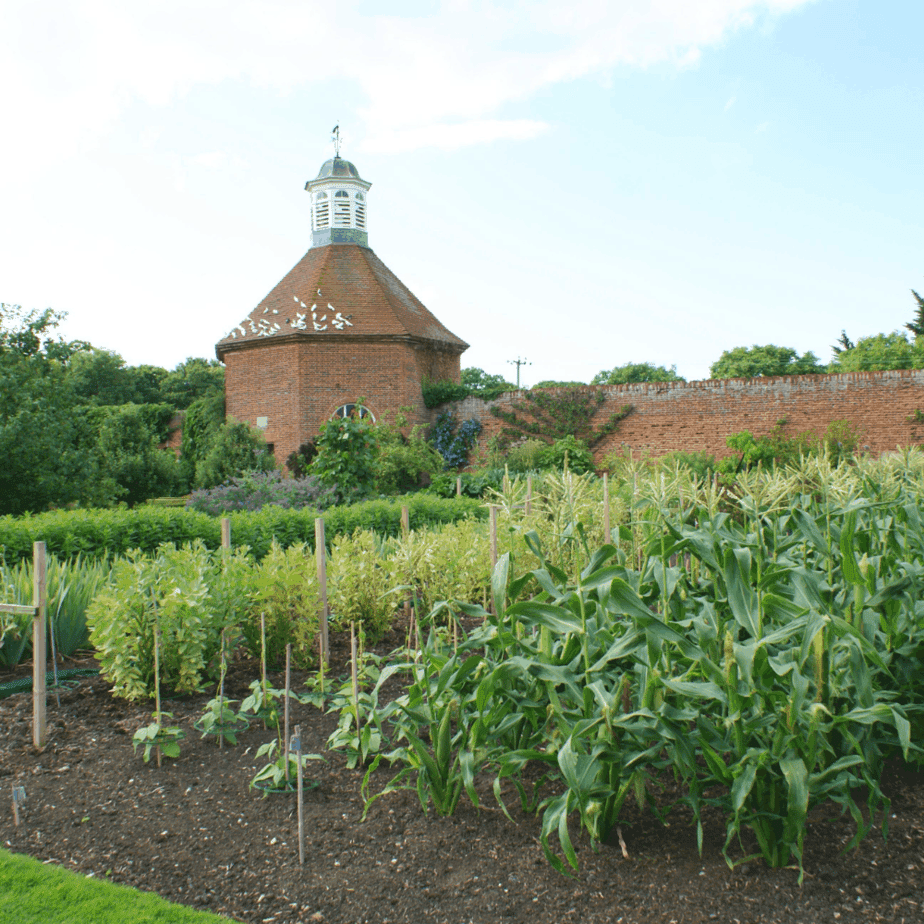
This is a job that will have a big impact on your success. In winter soil becomes compacted, The first step is to loosen the soil by digging down about 12″-14.” Amend the soil with compost, rake the soil level, and water lightly. This will release any air pockets in the soil.
Test your soil to check pH and nutrition levels. This will tell you what you need to add and prevent expensive guessing. Your county extension service will offer expert help. Ask them what levels of testing they offer and how they recommend you take the samples. At our county, we test on-site for pH (at no charge, my husband and I do this at our local plant clinic. We are not equipped to do the detailed testing and send the samples to our university lab for more detailed testing. Turnaround time is good, the price is reasonable and the reports are pretty edifying.
Soil
What is good soil, how can you improve your soil? Soil and How to improve it.
Existing Raised Beds
- Inspect and repair the beds before planting. It is a sad event to plant a bed that will not survive the growing season because it is in poor condition.
- Dig in any cover crop you have planted
- Remove any invading weeds or roots
- Soil in raised beds is constantly settling, add some material to lighten it. Till in compost
- You should be able to reach across any bed 4′ wide or less by working from both sides. If you have one you cannot reach across avoid standing on the soil. If you must enter the bed use a plank.
Prepare potting mix for your containers, window boxes, and hanging baskets. How to select a good potting mix?
5. Pruning Shrubs And Trees
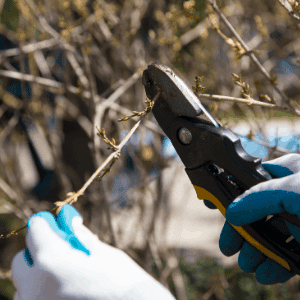
In late spring, pruning is easiest while the plants are dormant and you can see the structure clearly. In spring do not prune plants that bloom on old growth or wood. You will be removing your spring buds. These include the following plants.
- Spirea
- Camillia
- Rhodedendron & azaleia
- Forsythia
- Hydrangea macrophillia
- Syringia (lilac-
- Mountain Laurel
6. Divide Late Summer And Fall Blooming Perennials
Which perennial plants should I divide in the spring after they emerge? Any late summer and fall-blooming plants will benefit from division in the spring. Also, as new growth is emerging it is easy to see what you are doing. This allows the plants to devote all their energy to growing roots and foliage.
Conversely, the plants that bloom in the spring and early summer should be divided in late summer, before the first frost.
Here are Some Examples
- Daylilies
- Shasta Daisies
- Hosta
- Ornamental grasses and Sedges
Why Do I Want to Divide the Perennials?
Do this to improve the health of the plant itself. This will also provide you with new plants for your garden and to share with friends. We live on a street where the most popular plants make the rounds. We all wait for the best varieties.
How Do I Know When To Divide Plants?
In most cases about every 3-5 years. The plants will show you when they need to be divided. They may stop flowering, produce fewer or smaller flowers and you will see fewer bottom leaves. Often a sign is that the sides of the clump look fine but the middle seems to be dying. Dividing the plants will provide more space for the roots to grow.
How To Divide Them
There are two ways to do this. The first is to divide them where they grow. Using your shovel, cut through the root of the plant and dig it out in segments. This is the fastest procedure if you are experienced and have a lot of plants to divide.
The second method is more precise. Dig the entire plant and root ball up and place it on a tarp or drop cloth. This will make it easiest to see natural divisions in the crown, rhizome, or corms. A good rule of thumb is to split the root into sizes that will fit in a one-gallon pot. You can do this with a garden knife and often with your hands.
Each new section should have 3-5 vigorous new shoots.
When To Divide The Plants
Pick a cloudy, overcast day. In bright sun the plants will dry out. Water the plants to be divided the day before and If possible do this work when more rain is in the forecast. Have the new planting place prepared and replant as soon as possible. Add an all-purpose fertilizer and water the new plants.
I like this article, by the U. Minnesota Extension service. It includes a spreadsheet of plants by name with a division schedule for each.
Always use your local County Agricultural Extension Service for expert local advice. Here is how to find yours. Just put in your zip code.
Do You Have Any Shrubs That Absolutely Must Be Moved?
Moving mature shrubs always has risks, but sometimes one is absolutely in the wrong place! If you need to take the risk, do it while the plants are dormant. It is the least stressful option.
7. Plant Beds, Borders, And Containers
How To Find The Right Time
Follow these three steps.
Find Your Zone
This is the USDA plant hardiness zone map. Use it to find your plant hardiness zone. Also, When you buy plants that are perennial (last more than one growing season) check that they grow in your zone.
Choose The Plants You Need
Are you planting edibles? Plant what you like to eat. Kale is beautiful in the garden, and I am assured it is healthy. But, I am “Kale Impaired” to me, it never tastes better than a good brand of soap. Now spinach, and bok choi, I’ll have any old day.
I do think that it is beneficial to give yourself a little stretch each year. Add something new! I am trying some French radishes this year. Some years ago, I took cooking lessons from a student of Madelyn Kamann, a French chef who said that as a child her after-school snack was radishes, salt, fresh bread, and butter. I will try it, for old time’s sake!
Check Your Calendar
Take your plant hardiness zone and use it to follow a planting calendar. Here is one. I entered my zip code in this one and got a schedule of planting, by crop for my location.
Use your state Agricultural University research for most local results. The easiest way to access this is through your county Agricultural Extension Agent’s Office. These are your university faculty working in your specific area. You can’t get more local than that! Here is how to find your Extension service.
We are volunteer Master Gardeners in our county and we assist in getting university-based research and information to gardeners in our area. We run educational programs, Garden shows, workshops, and plant clinics. This month we are presenting (via Zoom) our 21st annual Garden Lecture series of 9 lectures and we are making our annual garden tour a virtual one.
Check out your volunteer gardening services, they are provided by your neighbors and I think you will like them.
Are You Planting Edibles-Is Your Space Limited?
I think that the best return on investment comes from raising compact garden herbs for flavor. You can use them raw or cooked, fresh or dried. Just toss them on salads or in soups. You can grow them in pots or even hanging baskets on patios, beside the door, and on balconies. Here is a guide to culinary herbs you can link from it to detailed herb articles and other posts on how to use them.
This Is The Time To Plant Summer Blooming Bulbs
Now that you have the soil prepared is time to plant summer-blooming bulbs. This is a great, and remarkably easy way to ensure a beautiful spring-to-summer transition ahead of time.
The bulb companies are beginning their shipment schedules and you can have the color of your choice wherever you want it. The time you save might give you an early beach day!
This article: “Its Time To Plant Summer Blooming Bulbs” will tell you what steps to take. If you find a flower you would like its name is a link to specific information about it. There is also a list of popular bulb shippers.
What’s Happening In Our Garden In Late Winter
If your garden is in a temperate climate-you are preparing for the cold to warm weather transition. We, in South Florida, are getting ready for the change from mild and dry- to warm and wet. We are already getting hurricane warnings from all the local media! (“Hurricane Proof Your Florida Yard and Garden“)
We are all ordering summer blooming bulbs. Our location in zone 10 places us at the beginning of the shipping list. We expect bulbs to plant within two weeks.
White Queen Caladiums: This is a beautiful, ethereal plant that can be grown in pots everywhere. You can use them in the ground and lift them up for winter storage in colder climates. Here is how to grow them wherever you are.
We use these in big bands throughout the garden for color throughout the long warm season. (Caladiums)
Summary, Reviewing the Perfect Spring Garden
So what’s next? Expert gardeners all say that “any fool can look good in springtime.” I know that setting up the spring garden takes work, but the point gardeners make is that every improvement you make in early spring looks great. But as spring turns to summer, your mistakes show up. The empty spots, dying tulips with nothing around to cover them. There are problems.
Here is how to make the next seasonal transition work. “Garden Transitions, Spring Turns To Summer.”
Don’t stop now, there are great things to come, those spring-planted summer blooming bulbs are coming up soon.
If you garden in a hot climate and your spring is humid, this discussion may help you. “In Our Spring Garden”
Gardens To Visit
The featured image at the top of this article is Pinewood Estate, which you can visit along with Bok Tower Gardens in Lake Wales Fl. A lot of good ideas for our gardens come from visiting successful gardens. Bok Tower Gardens is a unique place as it is located on the top of a rare Florida mountain. Here is how to see it. “The Complete Guide To 7 Florida Gardens You Must See.”
